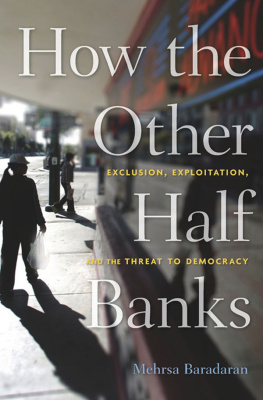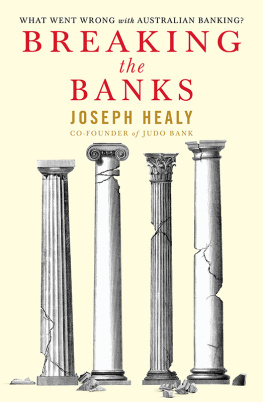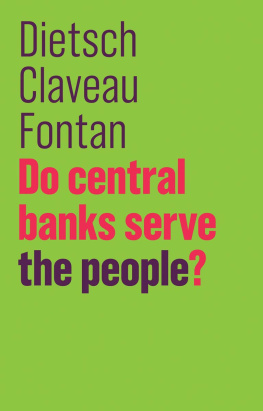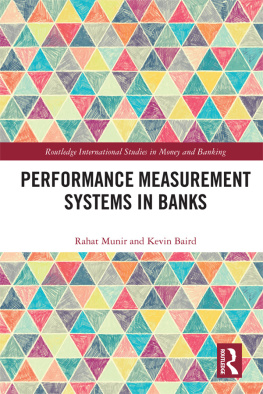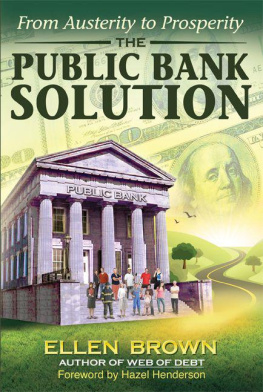MEHRSA BARADARAN

How the Other Half Banks
Exclusion, Exploitation, and the Threat to Democracy

Cambridge, Massachusetts, and London, England
2015
Copyright 2015 by the President and Fellows of Harvard College
All rights reserved
Jacket photo Sandy Huffaker / Bloomberg, via Getty Images
Jacket design by Lisa Roberts
978-0-674-28606-1 (hardcover)
978-0-674-49544-9 (EPUB)
978-0-674-49543-2 (MOBI)
978-0-674-49542-5 (PDF)
The Library of Congress has cataloged the printed edition as follows:
Baradaran, Mehrsa. 1978
How the other half banks : exclusion, exploitation, and the threat to democracy / Mehrsa Baradaran.
pages cm
1. Banks and bankingSocial aspectsUnited States. 2. Financial services industryUnited States. 3. Check cashing servicesUnited States. 4. Postal savings banksUnited States. I. Title.
HG2491.B269 2015
332.10973dc23 2015008022
Contents
Long ago it was said that one half of the world does not know how the other half lives. That was true then. It did not know because it did not care. The half that was on top cared little for the struggles, and less for the fate of those who were underneath, so long as it was able to hold them there and keep its own seat. There came a time when the discomfort and crowding below were so great, and the consequent upheavals so violent, that it was no longer an easy thing to do, and then the upper half fell to inquiring what was the matter.
JACOB RIIS, How the Other Half Lives: Studies among the Tenements of New York, 1890
One of the great ironies in modern America is that the less money you have, the more you pay to use it. The American banking industry has stopped serving those who are too poor to bank. Those who are unbanked must pay high fees to fringe banks just to turn their paychecks into cash, pay their monthly bills, or send money to a spouse or a child. The unbanked pay much of their incomeup to 10 percentjust to use their money. For these families, the total price of simple financial services each month is more than they spend on food. Indeed, it is very expensive to be poor.
This problem, however, reaches well beyond those traditionally considered poor. Ninety percent of Americans consider themselves middle class, yet anywhere from 20 to 40 percent of the population must rely on alternative financial instruments.
Thelma Fleming, a mother of three children and a grandmother of ten, lost one of her two jobs. To survive, she emptied her bank accounts, gave up her car, and pawned some of her possessions, including gifts from her grandchildren. When she still needed an extra $300 to cover monthly expenses, she went to a payday lender, who lent her the money at 300 percent interest. She would eventually take out five loans to buy the time she needed to pay off the original $300. When all was said and done, she had paid $2,500 in interest over the course of ten months in order to borrow just $300. She lost her bank account and ruined her credit in the process.
These stories of being trapped in debt are awful but also quite common. Most payday loans are followed by at least another loan but usually another ten payday loans. This life-ruining cycle of debt caused by high interest is an obvious problem, but it is just the tip of a much more pernicious iceberg. The very existence of the fringe banking sector is a symptom of a deep-rooted problem at the core of our financial system.
Consider another story. Steven earned great money before the financial crisis, but he had made some investments that all started to go bad during the crisis. From one day to the next, Steven couldnt pay his daily expenses. Despite all his best efforts, Steven was headed for financial ruin. He was confident he could get back on his feet if someone would just throw him a lifeline to survive this short-term financial emergency. Luckily, Steven found a miracle lender who would make generous loans and charge him interest at a rate well below market. The lender felt like it was in the lenders best interest that Steven avoid bankruptcy, so it was willing to ignore the obvious credit risk Steven posed.
This is a true story, but Steven is not a real person. Steven represents the largest American banks. That miracle lender is the federal government. This book will take a hard look at banking history to show why Tanya and Steven are treated so differently, why this striking inequality was not inevitable, and how it can be fixed.
Before discussing how we got here, a pervasive myth must be dispelled: this inequality is not caused by the basic economic laws of supply and demand, which require a higher cost of credit for the average person than for the average bank. For payday lending to be an appropriate market response or even a menacing market failure, basic economic rules and market consequences must govern our credit markets. They do not. Both Tanya and Steven should have failed, according to market rules, but the government intervened on Stevens behalf. In the United States, the banking market does not operate according to standard market rules.
The truth is that the source of Tanyas and Thelmas loans is the same as Stevens loanonly Steven got it for practically nothing, and Tanya and Thelma got it bundled with life-crushing interest. Put simply, payday lenders, which consist of a handful of large corporations, get their loans from the largest commercial banks at low interest. the Federal Reserve gives the bank a short-term loan, so it can survive without having to sell off valuable assets. All this federal government support makes the banking sector unlike other businesses that must create their own wealth, without the use of other peoples money or cheap loans, when they fall short.
But thats just the beginning. None of this takes Stevens loan, the government bailout, into account. These loans went on full display after the 2008 financial crisis. When the government directly pumps money into
The two presidents who administered the bailouts made it clear that the state must support the banking system, for if the banks failed, so too would the American public. President George W. Bush said in 2008 that he supported giving banks this urgently needed money so that they could avoid collapse and resume lending. This rescue effort, he emphasized, is aimed at preserving Americas overall economy [and helping] American consumers and businesses get credit to meet their daily needs and create jobs.
Two weeks later, then-presidential candidate Barack Obama sounded the same theme: All of usall of ushave a responsibility to solve this crisis because it affects the financial well-being of every single American. In other words, this is not just a Wall Street crisis, it is an American crisis. I understand completely why people would be skeptical when this President asked for a blank check to solve this problem. We are all in this together. We will rise or fall on that journey as one Nation and as one people.
In other words, the banks and the people were oneif the banks fell, so too, would we. We must lend to banks so that they can lend to us. This codependency of the government-banking system is not always clear, but the justifications given for the bailouts brought this crucial relationship into sharp focus: we need them and they need us. Many describe modern banks as private enterprises, but this is illusoryhalf-revealing and half-concealing their true nature. To be sure, individual banks are private companies, but each of these private banks sits atop a foundation of state support. In discussing the bailout of 2008, Bank of America CEO Ken Lewis made this key point well: We are so intertwined with the U.S. that its hard to separate whats good for the United States and whats good for Bank of America theyre almost one and the same.
Next page
